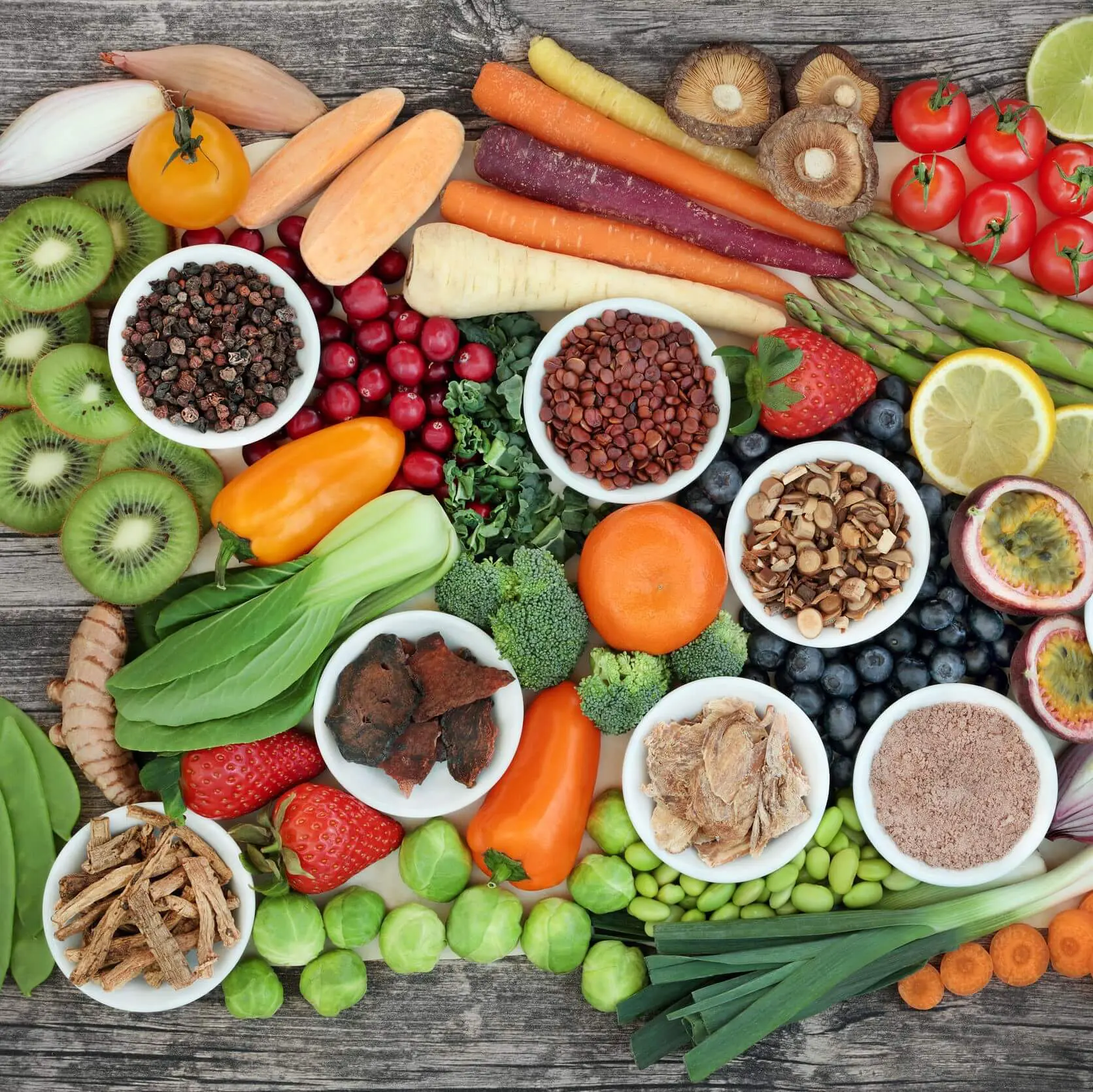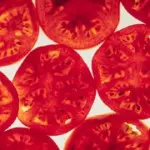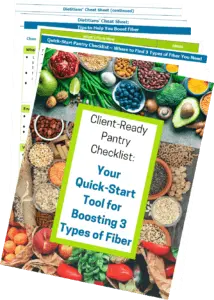
Tomatoes, Lycopene & Cancer: Complicated Story, Delicious Food
Does eating more tomatoes reduce your risk of cancer?
We’d all love simple answers to avoiding this all-too-common disease. Research in recent years has been focusing more on the potential of overall eating patterns than on specific nutrients or even single foods as cancer protectors. So the better question is, can tomatoes play a role in a diet that lowers cancer risk?
To that question, the answer seems to be yes, and today we’ll look at what that means. In addition, as an example of how to put this in practice, I’m sharing a soup recipe from my colleague and master-of-the-kitchen, Roberta Duyff, MS, RD.
Research on tomatoes, lycopene and cancer risk is definitely still ongoing, and although results are mixed, we can see benefit both in laboratory and human studies.
What the Research Says
Tomatoes are by far Americans’ largest source of lycopene, a red-colored carotenoid compound that you might consider a “cousin” to the more famous beta-carotene. Actually, tomatoes are also high in beta-carotene and several colorless carotenoids (especially phytoene and phytofluene). And tomatoes are high in vitamin C, too.
Because tomatoes are so important to U.S. intake of lycopene, much of the research is focused there. According to the American Institute for Cancer Research report summarizing the state of the research on diet and cancer risk, foods rich in lycopene probably lower risk of prostate cancer. Lycopene is a powerful antioxidant that may prevent DNA and other cell damage. In laboratory studies, many especially focusing on prostate cancer, lycopene stimulates self-destruction and decreases growth and spread of several types of cancer. Yet compared to lycopene alone, animal studies show even lower cancer risk from whole tomato powder, which includes other carotenoids and additional compounds, and from combining tomatoes and other cancer-protective plant foods.
Why It’s Not So Simple:
If lycopene is a unique and important influence on cancer risk, then it’s the lycopene circulating in the blood and acting locally in various body tissues that matters.
- We’ve learned that even if people eat the same amount of lycopene, they differ in how much they absorb from the digestive tract. Absorption of lycopene increases when it’s consumed with even a small amount of fat (think of olive oil dressing on raw tomatoes) or from foods that have been cooked.
- What’s more, genetic differences affecting how quickly people metabolize and excrete lycopene mean that even with the same initial level, it probably stays around longer in some people than others.
- Human studies of tomatoes and foods high in lycopene, mostly watching large population groups over several years, generally link higher intake with reduced risk of prostate cancer, and some show potential for lower risk of colorectal and stomach cancer. Prostate cancer studies are difficult to interpret because this disease takes so long to develop, with some types very aggressive and others slow-growing and probably not life threatening. Impact of tomato consumption may vary based on type and stage of this cancer.
- One analysis of eight population studies found higher circulating levels of total carotenoids, as well as levels of beta-carotene and lycopene, linked to lower breast cancer risk. Yet another analysis found links to total circulating carotenoids and beta-carotene, but not lycopene.
Tomatoes as Part of a Healthy Diet
When they are in season, fresh tomatoes, served raw, grilled or in kabobs can’t be beat. For people like me in the northern U.S. right now, however, canned (or some form of packaged processed) tomatoes are more economical and taste better. Some chefs say that out-of-season tomatoes are often a particular sturdy type that ship better but have less desirable texture and flavor, and picking them early to ship limits flavor further.
The glitch is that sodium can soar quite high, so be sure to choose processed tomatoes with no added salt. Even if you add a dash of your own, sodium content will still almost surely be lower than what you get in regular canned tomatoes. Add puréed or crushed tomatoes to soup, stew, chili, curry, lasagne, enchiladas, rice dishes, and many types of pasta.
Soup is a terrific way to include tomatoes when they’re not in season, and that doesn’t need to mean commercial tomato soup. Homemade tomato soup need not be daunting. Pureed tomatoes makes an especially easy way to make your own soup, though some foodies suggest that the flavor of whole canned tomatoes is even better than that of diced or pureed tomatoes, which they say may be a lower quality tomatoes. See the recipe below for a delicious example. And soup need not be a cold-weather item. Cold tomato soup, like gazpacho, is refreshingly delicious for a spring or summer lunch or dinner.
The bottom line: Tomatoes can be a delicious part of a healthy diet that includes a wide variety of vegetables, fruits, whole grains and beans. No food can supply all protective compounds, and to take greatest advantage of synergy with nutrients and phytochemicals from other foods, variety is key.
Sweet Pepper, Tomato and Leek Soup

I love this version of Tomato Soup by Roberta Duyff, MS, RD – especially with an extra dollop of plain yogurt on top
This soup combines leeks, tomatoes, red bell peppers, and fresh gingerroot with a minimum of fat to create a soup that tastes rich and delicious, but is low in calories, fat and sodium. What a nutritional goldmine!
- Not only do you get tomatoes’ vitamin C and lycopene; red peppers are extremely high in vitamin C and supply both beta-carotene and another carotenoid called beta-cryptoxanthin.
- And whereas many commercial tomato soups contain from 450 to 850 or more milligrams (mg) of sodium per serving – more than 25 to 50 percent of the recommended limit for a whole day for many people, including those over age 50 – this version contains less than 100 mg per serving as long as you used fresh or no-added-salt processed tomatoes.
1 tablespoon olive or vegetable oil
1 cup thinly-sliced leeks, both white and light green parts
1 garlic clove, minced
2 pounds (about 8 ripe) plum tomatoes, quartered
*Since fresh tomatoes are out of season in my area, I substituted a 28-oz can of diced tomatoes with No Added Salt, and the result was delicious.
2 large red bell peppers, cored, seeded, and cut into strips
1/4 cup freshly-squeezed lemon juice
1 teaspoon freshly-grated gingerroot
1 teaspoon salt 1/8 teaspoon freshly ground black pepper
About 1/2 cup plain nonfat yogurt to thin soup (you may also use buttermilk, or chicken or vegetable stock)
Fresh thyme leaves or minced chives
Makes 4 cups
Heat oil in a medium-sized saucepan over medium heat; add leeks and garlic. Cook and stir until leeks are tender, about 5 minutes. Add the tomatoes, bell peppers, lemon juice, gingerroot, and pepper. Cover and simmer over medium-low heat until the peppers are tender, about 30 minutes. Remove from heat; cool slightly.
In the bowl of a food processor fitted with a steel blade, puree vegetable mixture in batches until smooth. Thin to desired consistency with the yogurt. Serve hot or cold, garnished with thyme.
My Notes: You can also puree the soup in a blender, or if you are lucky enough to have what’s called an immersion (or stick) blender, you can puree the mixture right in the pan. The soup can be made 1 or 2 days ahead of serving and carefully reheated, or for summer, serve it cold (and season accordingly).
Thanks to Roberta L. Duyff, MS, RD, for sharing this recipe she developed. Roberta is the author of the American Dietetic Association Complete Food and Nutrition Guide, New York: John Wiley and Sons, 2012. Permission has been granted for me to provide this recipe, which is from Cooking with Les Dames D’Escoffier: At Home with the Women Who Shape the Way We Eat and Drink, Edited by Marcella Rosene
References
Giovannucci, E. Commentary: Serum lycopene and prostate cancer progression: a re-consideration of findings from the prostate cancer prevention trial. Cancer Causes & Control. 2011.
Eliassen AH, et al. Circulating carotenoids and risk of breast cancer: pooled analysis of eight prospective studies. J Natl Cancer Inst. 2012 Dec 19;104(24):1905-16.
Aune D, et al. Dietary compared with blood concentrations of carotenoids and breast cancer risk: a systematic review and meta-analysis of prospective studies. Am J Clin Nutr. 2012 Aug;96(2):356-73.
3 Comments
Leave a Comment
Published : February 28, 2013
Tagged: breast cancer, cancer prevention, healthy diet, healthy eating, lycopene, Mediterranean diet, plant-based diet, prostate cancer, recipe, reducing cancer risk, tomatoes, vegetables
Meet the author/educator
I Take Nutrition Science From Daunting to Doable.™
As a registered dietitian nutritionist, one of the most frequent complaints I hear from people — including health professionals — is that they are overwhelmed by the volume of sometimes-conflicting nutrition information.
I believe that when you turn nutrition from daunting to doable, you can transform people's lives.
Accurately translating nutrition science takes training, time and practice. Dietitians have the essential training and knowledge, but there’s only so much time in a day. I delight in helping them conquer “nutrition overwhelm” so they can feel capable and confident as they help others thrive.
I'm a speaker, writer, and nutrition consultant ... and I welcome you to share or comment on posts as part of this community!




Hi karen,
Thank’s for the lovley post.
what about green tomatoes and Solanine?
Great questions, Michal!
Green tomatoes do not have the lycopene (or lutein and zeaxanthin) found in red tomatoes. They also have lower amounts of beta-carotene and alpha-carotene, so vitamin A content is less, but even green tomatoes are a good source of these nutrients.
Tomatoes are members of the “nightshade” family of vegetables, which also includes potatoes, eggplant and peppers (sweet and hot types). These vegetables, along with thousands of herbs and shrubs, are members of the Solanacae plant family. These plants produce compounds called glycoalkaloids. Solanine is one of these alkaloids; tomatoes can produce related compounds called tomatines. Some people suggest that these compounds from “nightshade” vegetables may increase inflammation in the joints, posing problems for people with arthritis or gout. If someone with one of these conditions finds it worsened by eating these vegetables, then it would make sense to avoid or limit them. Alternatively, the alkaloid compounds reportedly decrease substantially when foods are cooked, so they might be able to eat cooked tomatoes and other nightshade vegetables, and also get carotenoids and lycopene from other sources. Some people worry that if eating these foods promoted inflammation, that could pose concern for many chronic diseases, even cancer. However, in limited laboratory studies, these same compounds have also shown the ability to inhibit growth of liver cancer cells and inhibit metastasis of melanoma. These studies are too preliminary to act upon. However, since consumption of tomatoes and other nightshade vegetables is clearly not linked with increased cancer risk, unless someone has pain or other individual reactions to eating tomatoes, I’d consider it jumping to unsupported conclusions to be afraid of these nutrient-rich foods. Of course, when it comes to individual health problems you have, always consult with your doctor regarding what is best for you.
Dear Karen,
Thank you for the detailed reply!